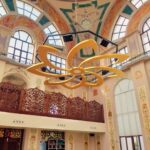How to Use the Arabic Alphabet in Environmental Education 🌍
Incorporating the Arabic alphabet into environmental education can be a fascinating and rewarding approach. Not only does it promote linguistic diversity, but it also opens the door to a deeper cultural understanding. Let’s explore how you can effectively use the Arabic alphabet to enrich environmental education for learners of all ages.
Table of Contents
1. Introduction to the Arabic Alphabet
2. Integrating Arabic into Environmental Lessons
3. Creative Activities for Learning 🌿
4. Benefits of Using the Arabic Alphabet in Education
5. Conclusion
6. FAQs
Introduction to the Arabic Alphabet
The Arabic alphabet consists of 28 letters and is written from right to left. It’s the script for many languages across the Middle East and North Africa. By using the Arabic alphabet in educational settings, you can bridge cultural gaps and foster a more inclusive learning environment. 🌟
Integrating Arabic into Environmental Lessons
It’s easier than you might think to incorporate the Arabic script into your lessons on the environment. Here are a few ideas:
Labeling Plants and Animals
Create bilingual labels for plants and animals using both the Arabic and Latin alphabets. This not only helps with vocabulary building but also makes learning more engaging.
Arabic Alphabet Nature Walks 🚶♀️
Organize nature walks where students can identify environmental elements and learn their names in Arabic. It’s an excellent way to blend language learning with environmental awareness.
Creative Activities for Learning 🌿
Arabic Alphabet Crafts
Get creative with craft projects that involve the Arabic alphabet. For example, students can create Arabic calligraphy on recycled materials, linking art with environmental consciousness.
Storytelling with Arabic Letters
Encourage students to write short stories or poems about the environment using the Arabic alphabet. This can spark creativity while reinforcing language skills.
Benefits of Using the Arabic Alphabet in Education
Incorporating the Arabic alphabet in environmental education has numerous benefits:
🔹 Promotes cultural inclusivity and appreciation.
🔹 Enhances cognitive skills by learning a new script.
🔹 Encourages curiosity about the environment and different languages.
Conclusion
Using the Arabic alphabet in environmental education is an innovative approach that enriches learning experiences. It not only enhances language skills but also fosters a deeper understanding of cultural diversity and environmental stewardship. By embracing this method, educators can create a more inclusive and engaging classroom environment. 🌱
FAQs
Q: What resources are available for teaching the Arabic alphabet?
A: There are numerous online platforms and apps that offer tutorials on the Arabic alphabet, including Duolingo and YouTube channels dedicated to Arabic language instruction.
Q: How can I make learning the Arabic alphabet fun?
A: Incorporate games, crafts, and storytelling into your lessons to make learning interactive and enjoyable for students.
Q: Is it necessary to be fluent in Arabic to teach it?
A: Not at all! You can learn alongside your students and use the experience as an opportunity to explore the language together.
By integrating the Arabic alphabet into your environmental education curriculum, you’re taking a step toward a more inclusive and enriching educational experience. Happy teaching! 🌟






